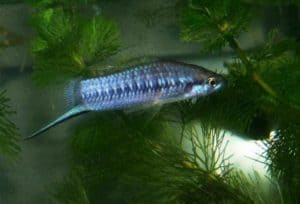Scientific Description Xiphophorus alvarezi
Description : Rosen,D.E.(1960) Middle-American poeciliid fisches of the genus Xiphophorus.Bull.Florida State Mus.,biol.sci.,vol.5, no.4:pp57-242.
Synonym: Xiphophorus helleri alvarezi Rosen 1960.
The name Alvarezi comes from Prof. Jose’ Alvarez here the name alvarezi is derived from.
Distribution
The highland basin in Chiapas;Mexico and Huehuetenago; El quiche an Alta Verpaz:Guatemala.
The range of several Xiphophorus species consists of northern and southern Xiphophorus. The Xiphophorus alvarezi is one of the southern Xiphophorus species. The Xiphophorus alvarezi is found in Rio Santo Domingo,chaipas in Mexico. There are two species in this group the red or yellow form.
Size:Males 6 cm and the females 7.5 cm.

Care and breeding
This is one of the more difficult Xiphophorus species to breed. With me it took over a year before I started to get the hang of it, and I now have a few youngsters swimming around.
What has struck me most of all is that it is better not to let the group be too large. My group consists of 4 females and 2 males. Of these, one male is very dominant and always chases the other male away from the females. Of course, the moment he gets his chance, the second male takes full advantage of this.
Also some young swim around,in this tank they swim together with the Suriname guppies these are guppies from Fred Poeser. On the bottom swim several Corydoras aeneus the albino form.

To clean up the algae, a Sturisoma areum (algae eater) swims around.
The Aquarium
My aquarium is 100 cm by 40 cm by 40 cm. Furthermore in me aquarium are several artificial plants. Also of course some different living plants. Plants and I don’t always go together here I don’t know the reason.
I also use an indoor filter and a pump with some effervescent stones especially summer recommended.
On the bottom I have riversand available at any hardware store. This Xiphophorus species usually keeps to the bottom or just halfway up the aquarium.
The temperature varies between 22 to 24 degrees here the xiphophoruusen feel best at home. My animals are from Ludo Couvreur (member of Poecilia Netherlands) and are really beautiful in color and type.
In my opinion, these fish rarely live more than 2 years, but they will have produced several litters. The young are sexually mature after about 5 to 6 months. However, it takes more than 1 year for them to mature. The female is tall in build and the male is slimmer and rounder in build. What I do want to tell you that they can swim pretty hard this makes photographing these really difficult.
Breeding Xiphophorus alvarezi
If the fish are comfortable and well cared for. Then the male and female proceeds very quickly to reproduce his species. He does this by dancing gracefully around the female. He then swims next to the female and in front of it and makes himself very beautiful to decorate the female and proceed to sex intercourse. ( This beautiful spectacle attracts me very much in this fish, hence my passion for Xiphophoruses)
For this he swims next to the female and by means of their gonopodium he proceeds to intercourse play.
After about 4 weeks the female gives birth to between 20 and 40 young at best. These then grow back into magnificent conspecifics of their parents in about 1 year.
The food
I use many different foods for these magnificent Xiphophoruses. As dry food I use Spirulina flakes mixed with artemia flakes and some concentrate. I then mix some dried mosquito larvae with dried water insects available in any pond store I also add some extra minerals and vitamins. Of course this is not necessary but I have had the best results.
Because I have the whole group in one tank I give the fish Artemia naupelien. This is mainly meant for the young fish the parents also like it of course. Furthermore I give them some frozen food and sometimes fresh red, white and black mosquito larvae. In summer, when I scour the ditches with my scoop net, I give them mysis, red water fleas and cyclops if I can catch them.


Literature
Swordtails and platties by dr.Herbert R.Axelrod and mr. Lothar Wischenath.
Lebendgebarende Zierfische vanArten der Welt.
And Poecilia special July 2005 written by Kees de Jong,Lars de Liefde,Jan de Moree, Rob Slinger and Leo van der Meer.
Author
Leo van der Meer – leo-aquarium.blogspot.nl
Copyright images
Leo van der Meer – leo-aquarium.blogspot.nl










